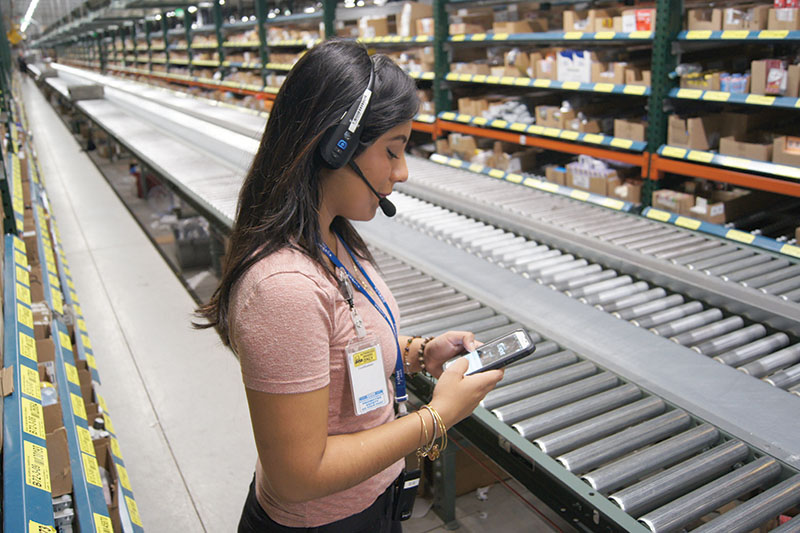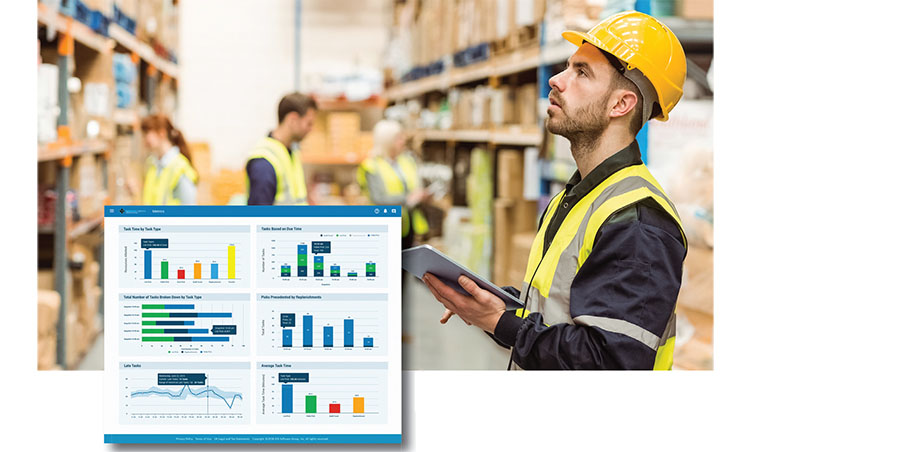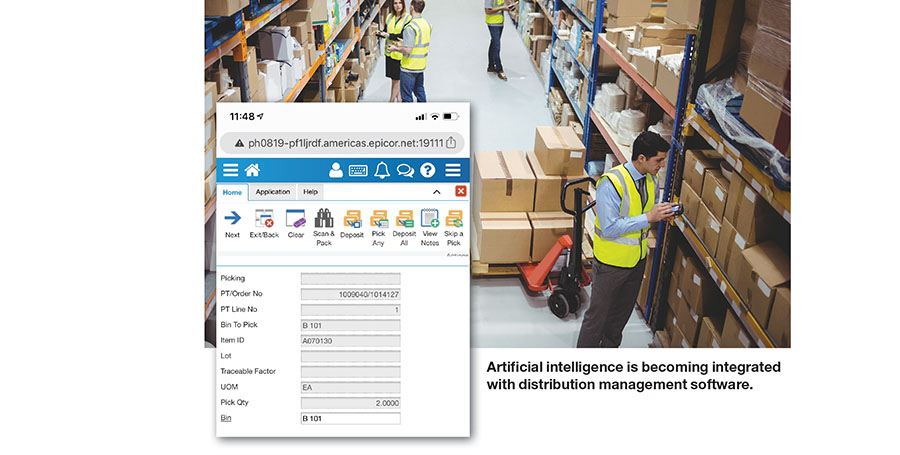Knock at the door: AI and IoT are ready for your warehouse
Artificial intelligence and the Internet of Things are making their initial forays into warehouse operations. The expected outcome is DCs able to respond dynamically to current supply chain conditions not pre-set rules. Look for newfound flexibility and an ability to respond to specific customer demands.

Talk about artificial intelligence (AI) and the Internet of Things (IoT) in the warehouse, and the room can get quiet very quickly. Are we at that point already? Are these next-generation technologies for real in the warehouse or just a talking point from some “visionary?”
Quite simply, yes, we are at the point where AI and IoT are real for the warehouse. Both are powerful new tools that better enable warehouse and distribution center activities to keep pace with rapidly shifting supply chain dynamics.
“Don’t be bamboozled by AI and IoT,” says Nate Brown, CEO of EVS. “Both are being used to solve the same problems as before. They just do it better. IoT provides data not previously available. It’s another level of understanding. AI analyzes micro-decisions and optimizes them to a level not previously possible.”
“IoT makes no sense without AI in the warehouse,” says Sean Elliott, chief technology officer at HighJump. “You need a combination of new data sources, that’s IoT, coupled with better solutions, that’s AI, to make sense of the data, develop insights and act on that knowledge. The two are front and center for improved operational performance,” he adds.
In addition, experts agree the two technologies are essential to accommodating the current shift from forecast-driven to demand-driven DCs.
All of that said, it is still very early in the game for both technologies, says Dan Gilmore, chief marketing officer at Softeon.
Some companies interviewed for this story don’t have a commercial offering yet. Others are in pilot. There are others that have offered a product for a short time. Looking forward, JDA, along with its partners, has committed $500 million in R&D over the next three years, says Steve Simmerman, senior director of sales/global partners and alliances.
Clearly, AI and IoT are knocking at the warehouse door. It’s a knock you want to answer.
Building out the IoT
Let’s face it, warehouses and DCs are under pressure like never before.
“Orders flow in all day long, and it’s expected that the DC will take action immediately. The challenge is figuring out how to best process those orders in a timely manner,” explains Adam Kline, senior director product management at Manhattan Associates.

Data granularity is a key enabler of more efficient operations.
As he goes on to say, even with a warehouse management system (WMS) in place those decisions are made with set rules, set capacities and set resources. However, there’s nothing static about those orders that just dropped. “Current conditions matter most going forward. Not preset rules. Now the systems intelligently balance capacity against resources, aiming to maximize utilization,” says Kline.
“AI and IoT team up to make decisions based on current conditions,” says Gilmore.
So, where exactly is all that IoT data going to come from? Believe it or not, some of it is already in place in your facility.
Materials handling equipment from conveyors to automatic guided vehicles and automated storage systems and the like all receive and send data about their activities. So do handheld devices from scanners to voice systems.
“Most facilities are bringing in more and more data devices that are developing into a burgeoning IoT network,” says Mark Jensen, senior director of product management at Epicor. Many times, simple sensors provide information not previously available for decision making. Smart phones are part of that new network.
Data about people figures prominently, too. “It matters where people are located at a given moment, what they are working on and how can they best be used,” explains Justin Ritter, director of project engineering at Lucas Systems.
As Kline of Manhattan points out, real-time locator systems are moving into place to track people and their availability for specific tasks. In fact, several types of real-time locator systems are available, including smart phones, passive radio beacons and RFID.
“Many facilities kind of know where Pete is based on his most recent scan. But when you use real-time locator systems, you know exactly where Pete is at all times,” says Gilmore.
There’s also the matter of people and robotics, Gilmore adds. He calls it a pairing capability to get both the right person and the right robot to fulfill an order using IoT data. “It’s a matter of pairing up the locations and having the two work together to pick and make a run to packing,” Gilmore adds. “New thinking is required here.”
Building out AI
As Richard Lebovitz, CEO of LeanDNA, says, “while access to data is becoming much simpler, most facilities lack the ability to decide how to use that data and what actions to take. It’s all a matter of bridging the gap between the forecast and what’s really happening in manufacturing.” That’s where AI enters.
Brown of EVS offers his baseline definition of AI in the warehouse. “It learns and reacts to the current state, not just a set of pre-set rules,” he says. That’s straightforward.
AI and IoT are not two sides of the same coin, explains Elliott of HighJump. “But they do have a symbiotic relationship. The more data about actions and interactions that AI receives, the more it can learn about how to adapt to current conditions,” he adds.
While much of the IoT data comes from within the four walls, take the example of a late inbound load. “The DC is alerted by an IoT signal being managed by a control tower that a load will arrive late,” says Simmerman of JDA. “AI takes that information and determines the optimal time to release and deploy a specific amount of labor to unload the truck. AI also determines what portion of that load should go directly to fill orders or to storage. Suddenly you have a new level of visibility and intelligence into how to make the DC operate most efficiently,” says Simmerman.
Getting to that point really does require the granularity of data that IoT delivers. “Data granularity is the key enabler to allowing AI to learn as new situations present themselves,” explains Graham Yennie, data scientist at Lucas. This particular form of AI is known as machine learning.
He goes on to explain that machine learning can take traditional industrial engineering out of the picture. “For example, engineers can build models and do time and motion studies to develop engineered standards. But it’s a time-consuming process. And, it’s locked into a point in time. Machine learning simply takes the data and uses algorithms to produce models on the fly based on current conditions. Furthermore, the model can adapt as conditions change. Better yet, AI learns with each iteration,” says Yennie. It’s all in the name of reducing process optimization costs and improving resource plans.
Bringing IoT and AI together
All of that is great. However, there is an even greater purpose to IoT and AI in the DC. The two technologies make it possible for a DC to move from being forecast driven to being demand driven. That is, when they are combined with WMS, warehouse execution systems and even work execution systems. Moving from forecast- to demand-driven operations is a huge but absolutely necessary pivot for DCs going forward, says Lebovitz of LeanDNA.
It’s all a matter of coping with the current shift from manufacturing and distribution calling the shots in the supply chain. Increasingly, customers are in charge to the extent that they have now transcended low costs as the primary driver of supply chain efficiencies.
As a result, a range of companies are investigating, piloting and fully integrating AI and IoT in warehouse operations.

Companies such as Lucas Systems and EVS are doing their due diligence to decide how to integrate the two technologies with their existing software packages. Lucas Systems expects to be deep into beta testing by next spring. Meanwhile, EVS is testing customer data with its WMS package.
LeanDNA has incorporated AI with its inventory analytics for manufacturing operations. Its software is used by a range of companies by connecting to their enterprise resource planning (ERP) systems to streamline operations.
Slotting and robotics are key to HighJump’s efforts to integrate the technologies with its WMS. Pilot projects are underway in both areas.
Softeon has an emphasis on tracking workers, their activities and equipment such as mobile robots using passive radio beacons. Slotting is also a key focus. Both have been integrated with Softeon’s WMS, which is now said to be able to make better decisions and faster.
Both IoT and AI are integrated with Manhattan’s warehouse execution package within its WMS. Order streaming, robotics and distribution control have all benefited since the capability was introduced almost 18 months ago.
Distribution management software from Epicor is just finishing beta testing of IoT. Meanwhile, AI is fully integrated into its virtual agent for its ERP system. The Cloud figures prominently here, too.
A little over a year ago, JDA purchased Blue Yonder and its AI capabilities. That has become a backbone in JDA’s strategy to digitize predictive analytics to create what the company is developing—a prescriptive state for the self-learning supply chain. IoT is just as integral to its long-term strategy. Control towers, the Cloud and warehouse tasking figure prominently.
It may be early in the use of IoT and AI in warehouse operations. And with all that’s calling for your attention day in and day out, it would be easy to overlook this development. But you would be better off if you didn’t let that happen.
Companies mentioned in this article

Article Topics
Latest in Logistics
LM Podcast Series: Assessing the freight transportation and logistics markets with Tom Nightingale, AFS Logistics Investor expectations continue to influence supply chain decision-making The Next Big Steps in Supply Chain Digitalization Under-21 driver pilot program a bust with fleets as FMCSA seeks changes Diesel back over $4 a gallon; Mideast tensions, other worries cited Four U.S. railroads file challenges against FRA’s two-person crew mandate, says report XPO opens up three new services acquired through auction of Yellow’s properties and assets More LogisticsSubscribe to Logistics Management Magazine

Find out what the world's most innovative companies are doing to improve productivity in their plants and distribution centers.
Start your FREE subscription today.
April 2023 Logistics Management

Latest Resources














